All grape varieties are sensitive to low temperatures, especially during awakening. Even frost-resistant species can be damaged by opening and awakening them too soon or incorrectly. This is especially true for all covering species. When planning spring work with this culture, it is important to focus on weather conditions, forecasts, recommendations for each region.
Content
Opening date
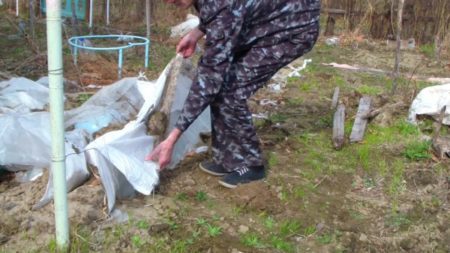 There are no specific deadlines in which it is recommended to fully complete such a procedure. Specialists advise beginners to focus on the middle, the end of March - the middle of April. During this period, you need to be especially careful about the weather, have time to inspect the shelters and plan all the work on a smooth awakening.
There are no specific deadlines in which it is recommended to fully complete such a procedure. Specialists advise beginners to focus on the middle, the end of March - the middle of April. During this period, you need to be especially careful about the weather, have time to inspect the shelters and plan all the work on a smooth awakening.
Weather
Weather is the main thing to consider. Both air temperature and its humidity, the forecast for precipitation, fluctuations in night and day readings are of importance. The first stage of the discovery is getting rid of snow. It should be started even before the covers melt, but then, when the daily temperatures rise already above minus 5 degrees. In most regions of Russia, this is mid-March, in the southern regions - the beginning of the month, and in the northern latitudes beginning of May.
The plant is fully opened when the average daily temperature reaches plus 10 degrees and does not fall below. You can focus on the condition of other plants. At this time, the buds begin to swell in the trees. The soil is already drying out well, warming up a bit, the grapes begin to wake up on their own.
In some regions, especially in Siberia, in the Far East, such weather conditions are rare in the spring. Therefore, in such areas it is better to focus on a temperature of +2 degrees Celsius. Frost-resistant vines will be able to transfer even night frosts to minus 5 degrees in the open state.
If the spring weather is not happy with heat, you do not need to rush to the opening. You can use the closed ventilation method to gradually awaken the bush. In the shelter, make fairly large holes every 5-7 centimeters. Air and even sunlight will penetrate through them, the vines will gradually become accustomed to temperatures. You can check the condition of the grapes without fully opening. If the buds are swollen, it is permissible to leave the bush in a covered state. If germination has begun, even weak, it is time to get rid of the winter cover.
Dates for regions
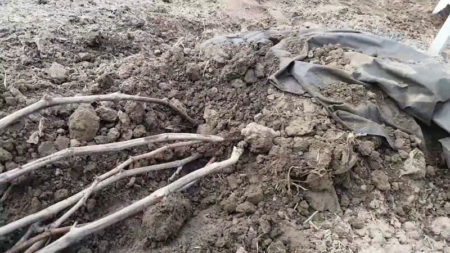 Lovers and beginners can determine the terms for a particular region by contacting local schools for growing and cultivating grapes. Especially relevant - this is in the areas of so-called risky farming. You can focus on the table, which corresponds to the average climate standards. For Russia, it looks as follows:
Lovers and beginners can determine the terms for a particular region by contacting local schools for growing and cultivating grapes. Especially relevant - this is in the areas of so-called risky farming. You can focus on the table, which corresponds to the average climate standards. For Russia, it looks as follows:
| Region | Desired Duration | Allowed Term |
| Moscow region, Volga region | mid april | early May (with the preservation of night frosts in April) |
| South of Russia | March 20 - April 15 | April 1 - April 20 (in the presence of snow cover) |
| Ural, Siberia | April 20 - May 20 | May 1 - June 1 (with late snow melting and increased soil moisture) |
| Far East | April 15 - May 15 | until June 1 (while maintaining regular precipitation and lowering night temperatures) |
In the Ukrainian Climate Conditions, which differs in the earlier spring, the abundance of seasonal precipitation and generally favorable conditions for early awakening, such a table is as follows:
| Climate zone | Desired Duration |
| South | March 1 - March 15 |
| Forest-steppe zones: Dnieper, Kremenchug, Volchansk | March 10 - April 10 |
| Polesie: Volyn, Kiev, Chernihiv, Zhytomyr | April 15 - May 15 |
All regions of Belarus differ in rather difficult conditions for lovers of grapes. Although spring is usually warm here, snow cover is late, the soil dries out slowly, and night frosts remain a threat to most plants for a long time. In all regions of the country, extra-early and early varieties are recommended for planting. They should be opened from mid-April to mid-May. In this case, it is better to focus on the variety and specific weather conditions, so the recommendations for the regions are the same.
Why timing is important
Some novice "breeders" of cultivated grapes may mistakenly believe that a later discovery would be the right decision. This, of course, will protect the grapes from freezing, however, it can lead to a sharp decrease in the number of crops. Therefore, it is important to correctly calculate the period and open the plant on time.
The main danger is freezing. The kidneys die before the shoots. Most varieties are able to continue the growth of vines from a frozen formation, from the spare and side shoots. However, it is rare that a crop is obtained from such branches. If the bush is frozen due to an early opening, it will most likely not bear fruit not only for one year, but also for the next one.
Late opening may lead to consequences such as:
- breaking off shoots;
- rotting of the kidneys;
- the development of fungal diseases.
Under the film, which is often used for shelter, condensation forms when heated by the sun. In such an environment, mold and fungus develop rapidly. The contrast between the temperature of cold soil and warm air already coming from the surface is not good for grapes.
If the buds not only have time to swell, but also germinate, it will be very difficult to keep them when opening and garter. More than half usually die in the course of further work. The yield of each bush is correspondingly reduced by the same amount.
Shelter Methods
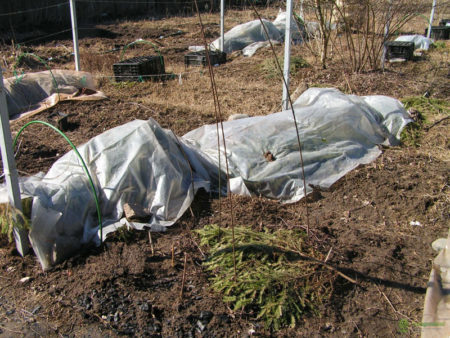 To open live grapes in spring with slightly swollen kidneys, you need to choose the right shelter method. It depends on the region, variety and capabilities of the owner. In total, three main technologies are distinguished:
To open live grapes in spring with slightly swollen kidneys, you need to choose the right shelter method. It depends on the region, variety and capabilities of the owner. In total, three main technologies are distinguished:
- complete shelter;
- partial warming;
- digging up with soil.
Half-shelter is characteristic of the Middle Strip and temperate climate. The roots are spudded, the vines and the trunk are placed in special insulated “sleeves”, they are all covered with a thick layer of protective materials. In the spring, the upper sleeves are first removed and branches are opened. After two to three days, the rest of the plant is released.The soil under the grapes is immediately covered with geomaterial to enhance heating and accelerate the process of awakening.
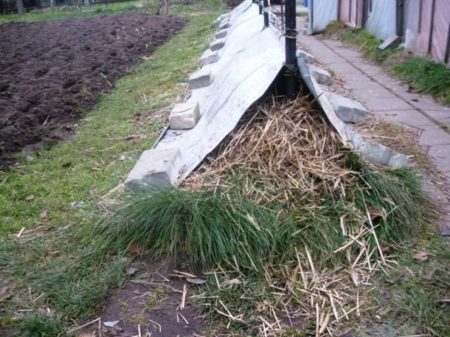 Full shelter It can be used in the Middle Band for southern heat-loving varieties, but it is advisable in the North, in Siberia, in the Far East. The branches are neatly laid on a wooden base, then covered with natural insulation and then wrapped with geo-fabrics for protection. The top layer is a film or roofing material. Opening is carried out in several stages with an interval of 3-4 days. After the last layer of insulation has been removed, build a temporary greenhouse or greenhouse.
Full shelter It can be used in the Middle Band for southern heat-loving varieties, but it is advisable in the North, in Siberia, in the Far East. The branches are neatly laid on a wooden base, then covered with natural insulation and then wrapped with geo-fabrics for protection. The top layer is a film or roofing material. Opening is carried out in several stages with an interval of 3-4 days. After the last layer of insulation has been removed, build a temporary greenhouse or greenhouse.
With full shelter, it is worth considering the possibility of hardening grapes, especially if these are young plants. In the first days after waking up, not only frosts, but also prolonged exposure to direct sunlight are dangerous for the kidneys and shoots. After the construction of a temporary shelter, it should be periodically opened so that the plant is accustomed to light, wind and temperature. The first "session" should last no more than 15 minutes, in the subsequent time it can be doubled. It is not advisable to harden in the shade, later the vines can get sunburn, especially in May, when exposure to direct rays is extremely dangerous for tender young leaves.
Spring work
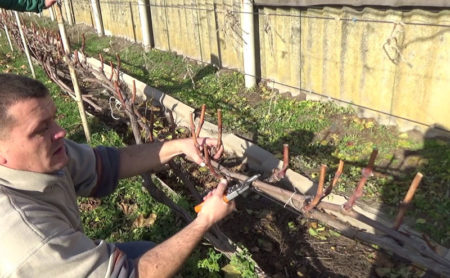 In spring, the first measures for the care of awakened grapes should be aimed at protecting it from return frosts. Therefore, during this period the plant is not watered, even if the soil is dry enough, and there was very little snow. The less moisture there is in the soil, the greater the chance of root survival at lower temperatures.
In spring, the first measures for the care of awakened grapes should be aimed at protecting it from return frosts. Therefore, during this period the plant is not watered, even if the soil is dry enough, and there was very little snow. The less moisture there is in the soil, the greater the chance of root survival at lower temperatures.
The first stage of processing is a garter. It is carried out after the vines have dried, in this state they are more flexible and less fragile, so you can form a bush of the desired shape. On the lower tiers are placed those vines that give the greatest yield. Raising them too high is not worth it to avoid pulling under its own weight, the optimal height is 30-50 centimeters, depending on the size of the variety and the age of the bush. During the first garter, inspection is performed by removing non-viable branches. To determine if cut off a branch, you can make control sections at a distance of 1 centimeter from each other. If the core is not black or brown, the branch should be left. The first the garter is performed only horizontally, after, approximately in the middle of May in the south and in the middle of June in the north, they conduct the second course of forming the bush. All new shoots are distributed on the trellises.
Immediately after lifting from the ground, the earth should be thoroughly loosened. Particular attention is paid to the presence of mold, which could appear when covered with film materials. The soil is immediately treated with special antifungal drugs until the disease has spread to the plant. The grapes themselves after tying sprayed solution of copper sulfate: dissolve 300 grams of dry matter in 10 liters of lukewarm water.
Immediately after liberation from shelter, fertilizer can be applied using the root method. This is not done if you need to slow down the opening of the kidneys when predicting frost. With a favorable prognosis, you can make ready-made mixtures, such as Agrolife, as well as fertilizers collected independently. For the first feeding, the proportion is suitable: 5 parts of nitrogen-containing substances, 4 parts of phosphates, 3 parts of potassium compounds.
Reviews
Ilya
I grow grapes in the Urals already 7 years old. I use only full shelter and in the spring I open the vines stably in late April. First I make the ventilation holes, very small, then in a couple of days I expand it, after which I start to open the film materials. I advise you to do this in the early morning, when the sun is bright, but not "burning".I do this even with young plants, the losses are very small, but without this in any way.
Veronica
We grow grapes for ourselves and a little for sale in Krasnodar. We always open early, in early March. If, according to the forecast of freezing, we process it with iron sulfate, make a weak solution. This inhibits the growth of the kidneys, and protects against diseases. We always try to open early, so that the kidneys are very small, and the soil is still wet, it dries quickly with us.
The discovery of grapes is the first stage of the vegetative period. Correctly calculating the time is very important both in the northern regions, where late frosts are likely, and in the southern ones, where high daytime temperatures often coexist with low nighttime temperatures. Guided by standard terms, as well as recommendations for a particular variety, you can not only determine the correct opening time, but also the best schedule for further processing. This will allow you to get strong plants with a large number of buds and fruiting shoots.




 Non-covering winter-hardy grape varieties for Moscow region
Non-covering winter-hardy grape varieties for Moscow region How to keep the vine in winter
How to keep the vine in winter When can I transfer grapes to another place in the fall
When can I transfer grapes to another place in the fall How to cover and prepare grapes for the winter in the suburbs
How to cover and prepare grapes for the winter in the suburbs